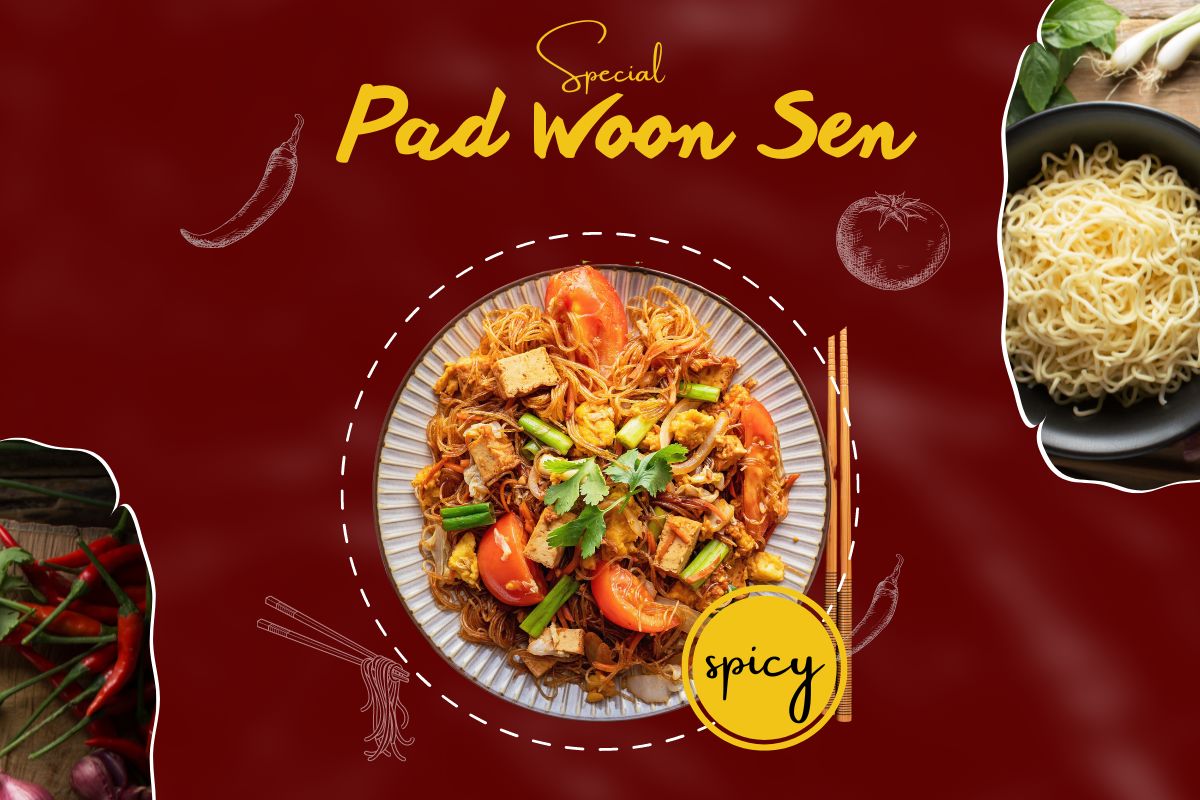Pad woon sen is a yummy Thai dish made with glass noodles that are stir-fried with tasty ingredients. You might not have heard of it as much as Pad Thai, but it’s worth trying! It’s like a flavor explosion in your mouth, with lots of different textures and yummy tastes. It’s super easy to make, so it’s great for a quick meal during the week. Plus, it’s perfect to serve at a Thai-themed party or dinner.
Unveiling the Glass Noodles: Woon Sen
In Pad Woon Sen, the real star is the woon sen, which is also called glass noodles, mung bean noodles, or cellophane noodles. These noodles are made from mung bean starch and have a cool texture that makes them different from other Asian noodles. When they’re dry, they look white and solid, but when you soak or cook them, they turn into a bouncy and kinda chewy treat. They don’t have much taste on their own, but they soak up all the yummy sauce from the pad woon sen, so every bite is bursting with flavor.
A Symphony of Savory Flavors: The Pad Woon Sen Sauce
The magic of pad woon sen lies in its simple yet incredibly flavorful sauce. While variations exist, the core ingredients typically include:
- Oyster Sauce: This thick and tasty sauce brings out a rich and savory flavor that’s super important in making the pad woon sen taste so good. It’s like the main ingredient that gives the dish its awesome taste.
- Soy Sauce: Soy sauce adds a special flavor to the sauce by mixing in a bit of saltiness that complements the sweetness of the other ingredients.
- Fish Sauce (Optional): To make food taste even more flavorful, some recipes add fish sauce. Fish sauce is a type of seasoning made from fish that adds a savory taste to dishes.
- Golden Mountain Sauce (Optional): This special Thai sauce is made using palm sugar, tamarind, and chilies. It gives a bit of sweetness along with a tangy taste.
- Sugar: Adding a little bit of sugar to a dish can enhance its taste by making it more balanced and bringing out the flavors. It also goes well with savory ingredients, making them taste even better together
- White Pepper: When you freshly grind white pepper and add it to your dish, it brings a gentle warmth and flavor to the food.
These ingredients are typically whisked together in a small bowl before being incorporated into the stir-fry.
Adding Color and Texture: The Vegetables
Pad woon sen is a versatile dish that welcomes a variety of vegetables. Some common inclusions are:
- Eggs: Scrambled eggs add a delightful protein element and textural contrast to the dish.
- Bean Sprouts: These crunchy sprouts add a pop of freshness and a mild bean flavor.
- Green Onions: The verdant green onions offer a welcome freshness and a slight oniony bite.
- Garlic and Shallots: Aromatics like garlic and shallots form the base of the flavor profile.
- Other Vegetables: Depending on your preference, you can include vegetables like shredded carrots, broccoli florets, or chopped mushrooms for added color, texture, and nutrients.
These vegetables are stir-fried separately or along with the protein to ensure they retain their crispness.
Protein Power: A Customizable Choice
Pad woon sen can be enjoyed as a vegetarian dish, but for those seeking a protein boost, there are several options:
- Chicken: Thinly sliced chicken breast is a popular choice, marinated beforehand for added flavor.
- Shrimp: Plump and juicy shrimp add a delightful seafood element.
- Tofu: Cubed and pan-fried tofu provides a meaty texture for vegetarians.
- Other Proteins: Feel free to experiment with other protein sources like thinly sliced pork or even crumbled tempeh.
The protein element is typically stir-fried first, followed by the vegetables and finally tossed with the cooked noodles and sauce.
The Art of the Stir-Fry: Bringing it All Together
The beauty of pad woon sen lies in its simplicity. Here’s a basic outline of the cooking process:
- Soak the Glass Noodles: Follow the instructions on the package. Put the woon sen in warm water and let it sit until it becomes soft and squishy.
- Prepare the Sauce: Mix the oyster sauce, soy sauce, fish sauce (if you’re using it), Golden Mountain sauce (if you’re using it), sugar, and white pepper in a small bowl. Stir them together until they’re well combined.
- Cook the Protein (Optional): Marinate and stir-fry your chosen protein until cooked through.
- Stir-fry the Vegetables: First, put a small amount of oil in your wok or pan. Then, cook the vegetables by stirring them in the pan until they are just tender but still a bit crunchy. This helps keep them flavorful and nutritious.
- Incorporate the Noodles: Add the drained and softened glass noodles to the pan with the vegetables and protein (if using).
- Pour in the Sauce: Give the sauce a quick stir again and then pour it over the noodles and vegetables in the pan.
- Toss and Combine: Using tongs or a spatula, toss everything together until the noodles are evenly coated with the sauce and heated through.
Enjoying Pad Woon Sen
Whether you’re a Thai cuisine enthusiast or just looking for a delicious and easy-to-make meal, Pad Woon Sen is sure to satisfy your cravings. With its vibrant flavors, customizable ingredients, and simple cooking process, it’s a dish that’s perfect for both weeknight dinners and special occasions. So, grab your wok and get ready to indulge in the mouthwatering world of Pad Woon Sen!
Tags: Noodle Stir FryPad Woon SenQuick RecipeThai Cuisine

